Abstract
1. The pharmacological properties of a benzodiazepine receptor (BZR) partial agonist, Y-23684 were investigated in comparison with those of diazepam, a conventional BZR full agonist. 2. Y-23684 and diazepam showed high and selective affinity for the BZR with Ki values of 41 and 5.8 nM, respectively. 3. In contrast to diazepam, variability was noted in the anticonvulsive potency of Y-23684 depending on convulsants (bicuculline, pentylenetetrazol and maximal electrical shock). Y-23684 produced the most potent protective effect against bicuculline in rats and mice with ED50S of 1.3 and 1.2 mg kg-1, respectively. 4. In rat conflict models (Geller-Seifter and water-lick tests), Y-23684 produced an antipunishment action at doses 2-4 times lower than diazepam. In contrast to diazepam, Y-23684 did not affect unpunished responding up to 50 mg kg-1 in the Geller-Seifter test. 5. In other rat models of anxiety (social interaction and elevated plus-maze tests), Y-23684 was as efficacious as and ten fold more potent than diazepam. In a mouse model of anxiety (exploration (light/dark box) test), Y-23684 was as efficacious and two fold less potent as diazepam. In these paradigms, Y-23684 showed a selective anxiolytic profile over a wide dose-range without loss of efficacy and sedative action. 6. The impairment of motor coordination (rotarod) and potentiation of CNS depressants (ethanol and hexobarbitone) by Y-23684 was much weaker than that of diazepam. 7. These results suggest that Y-23684 would be a potent and selective anxiolytic agent in man with less side-effects than conventional BZ-anxiolytics.
Full text
PDF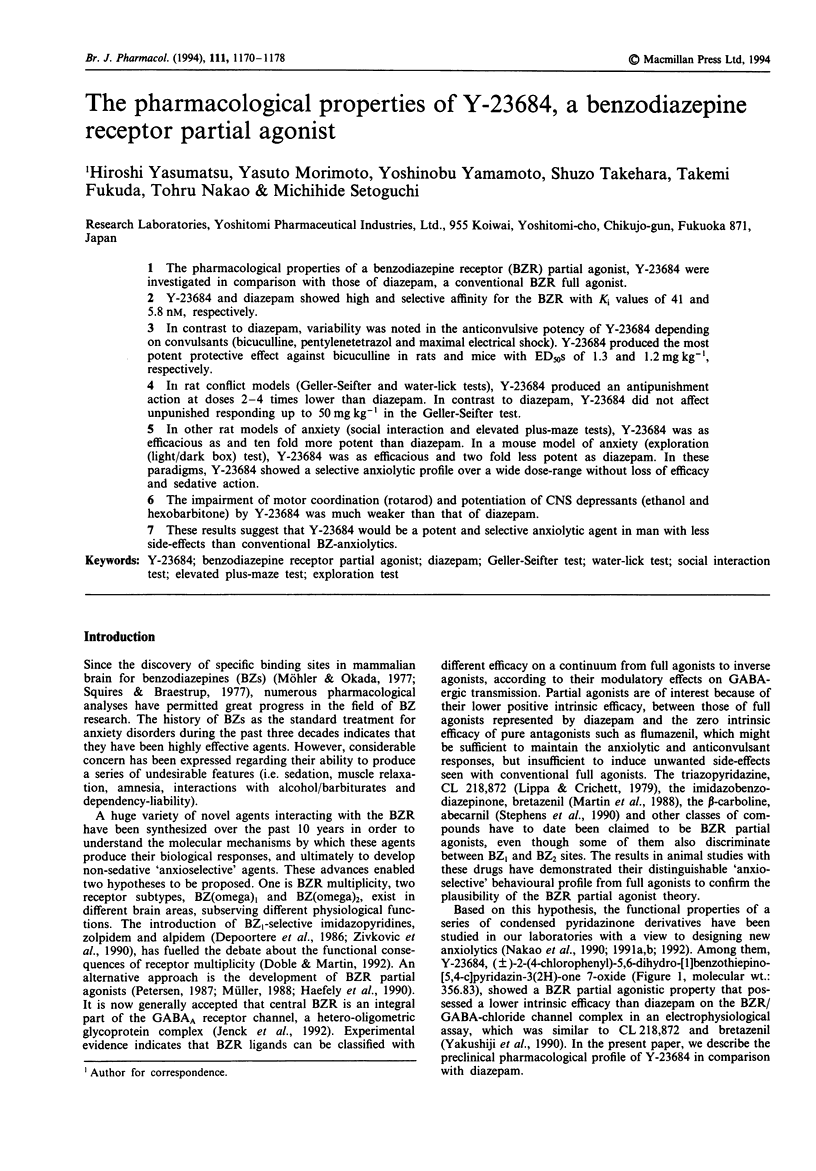
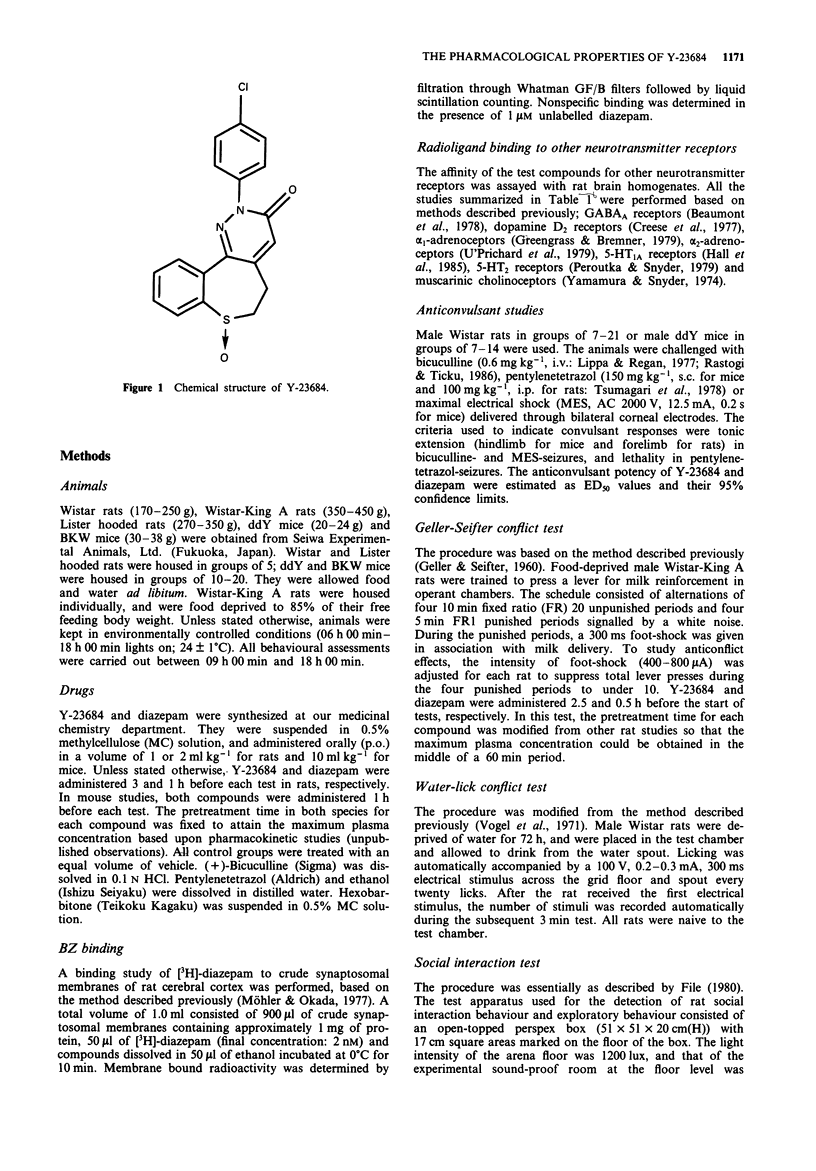
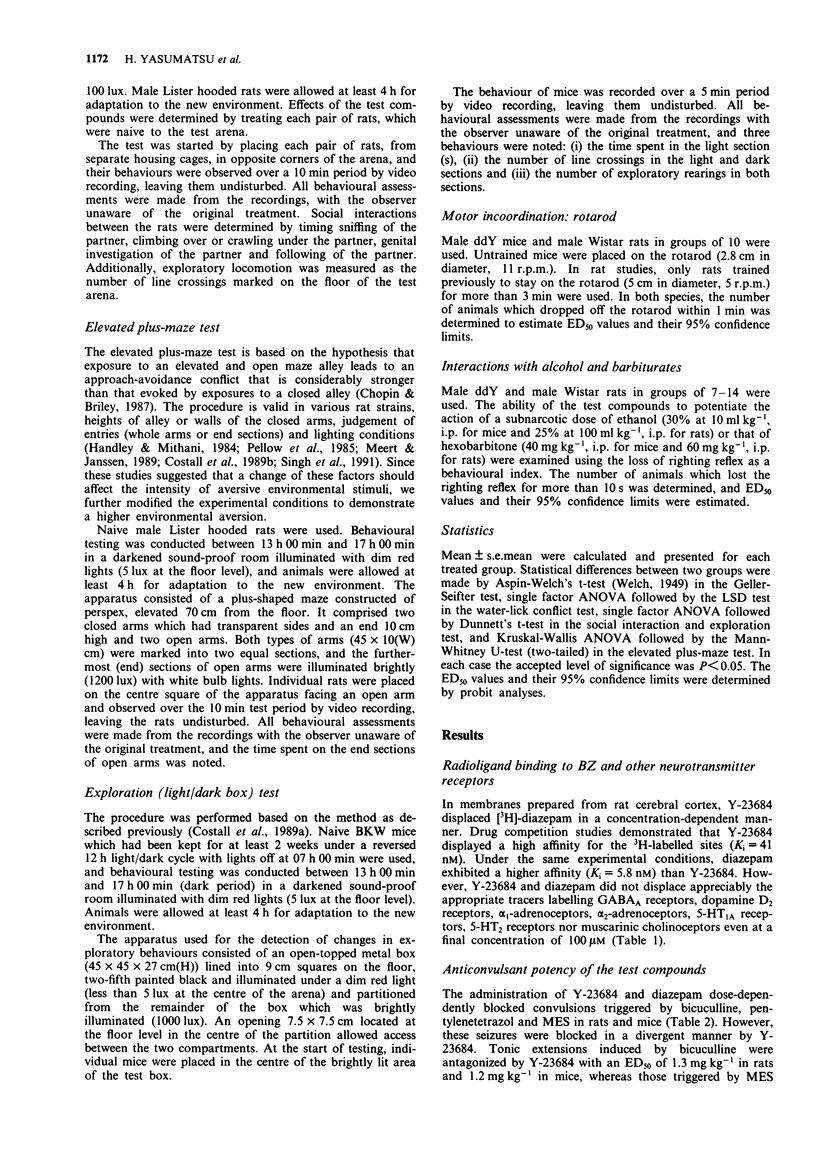
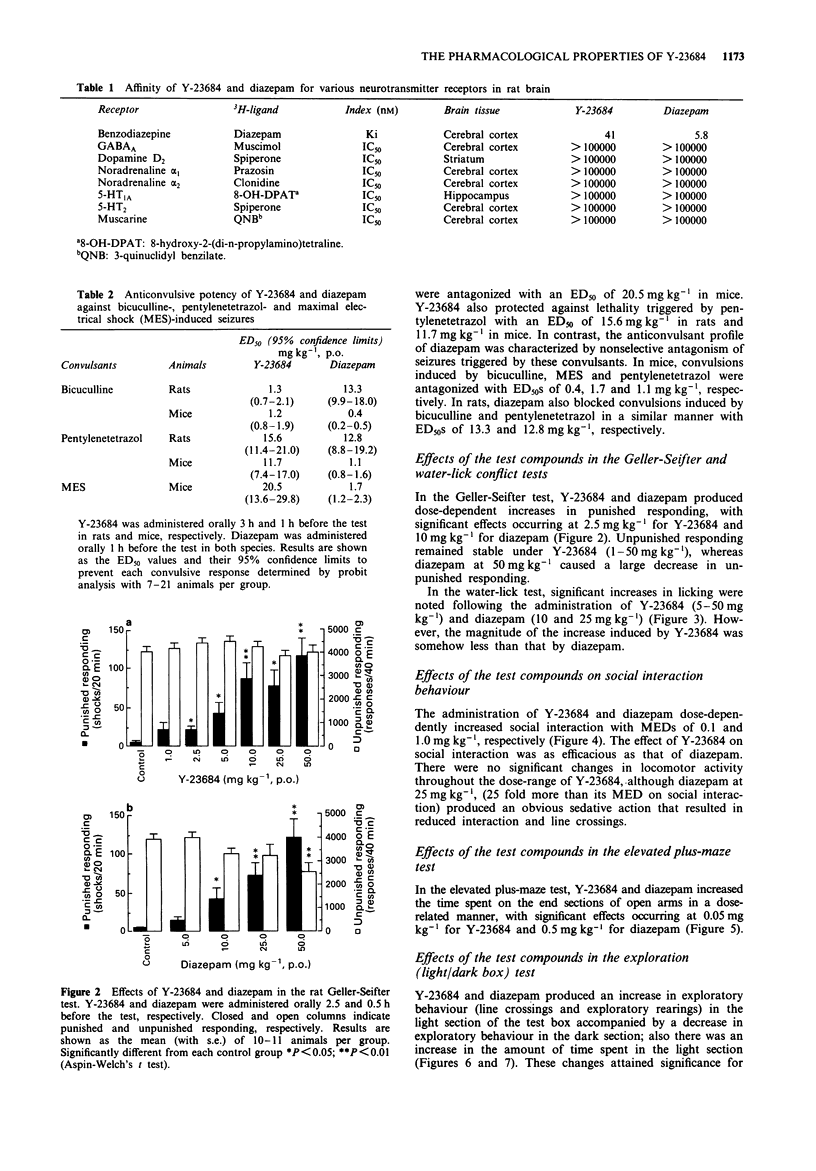
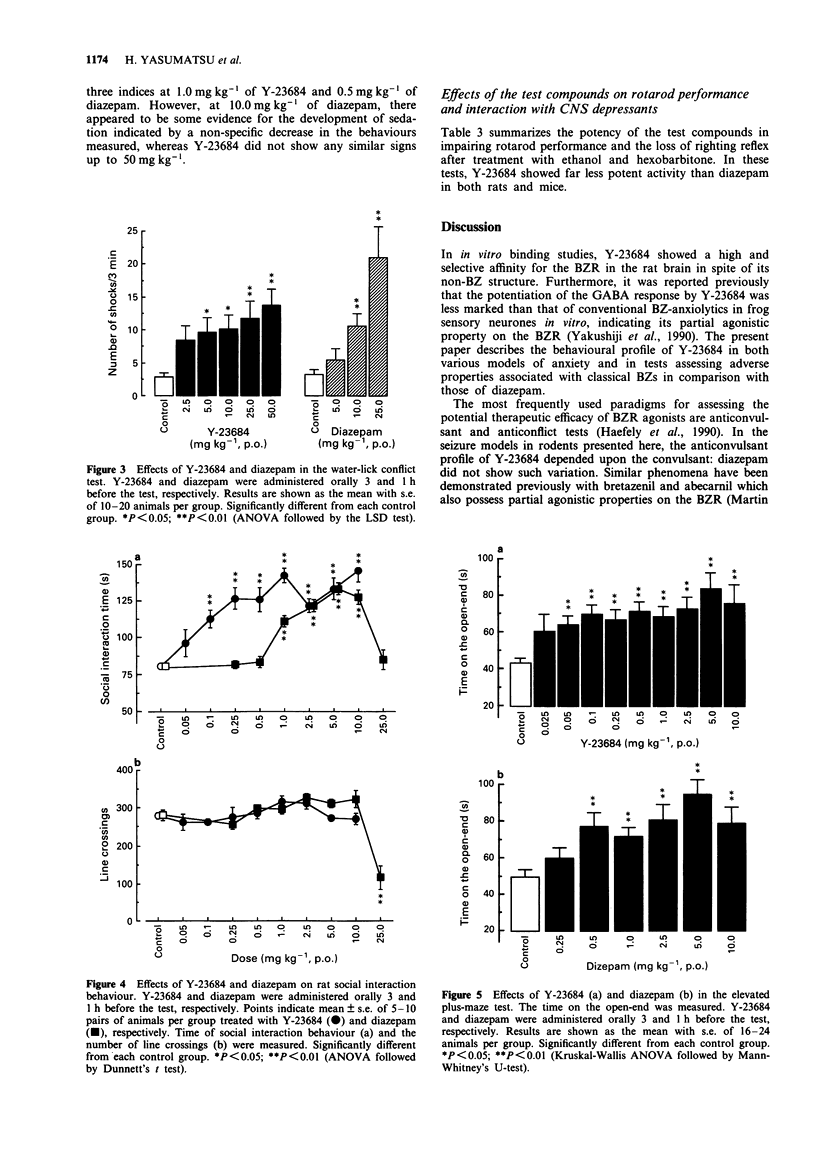
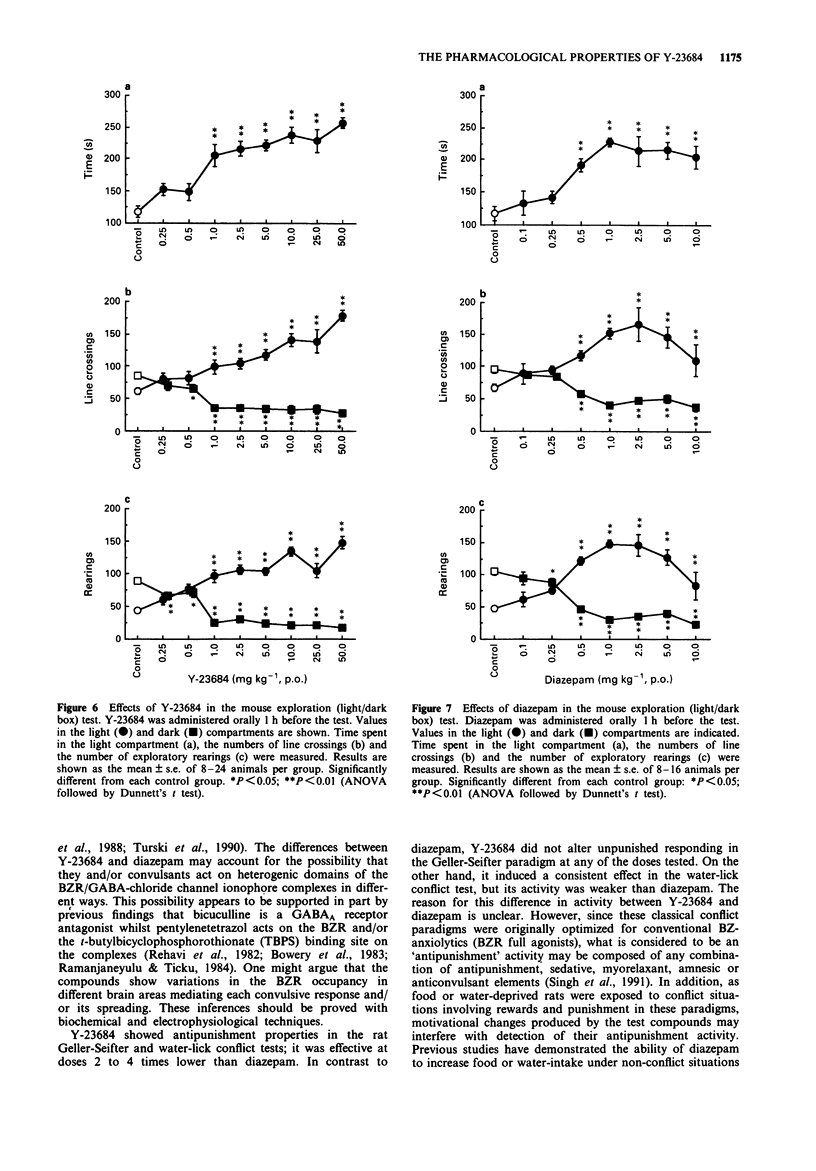
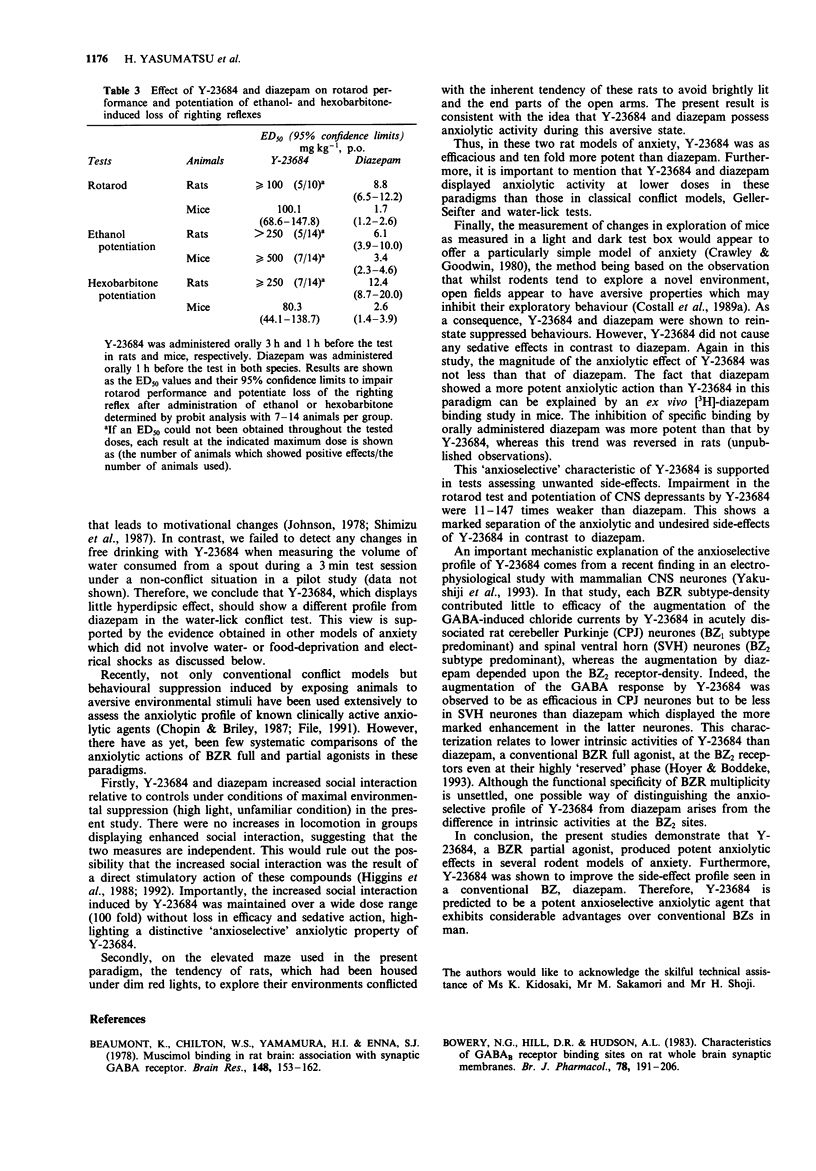
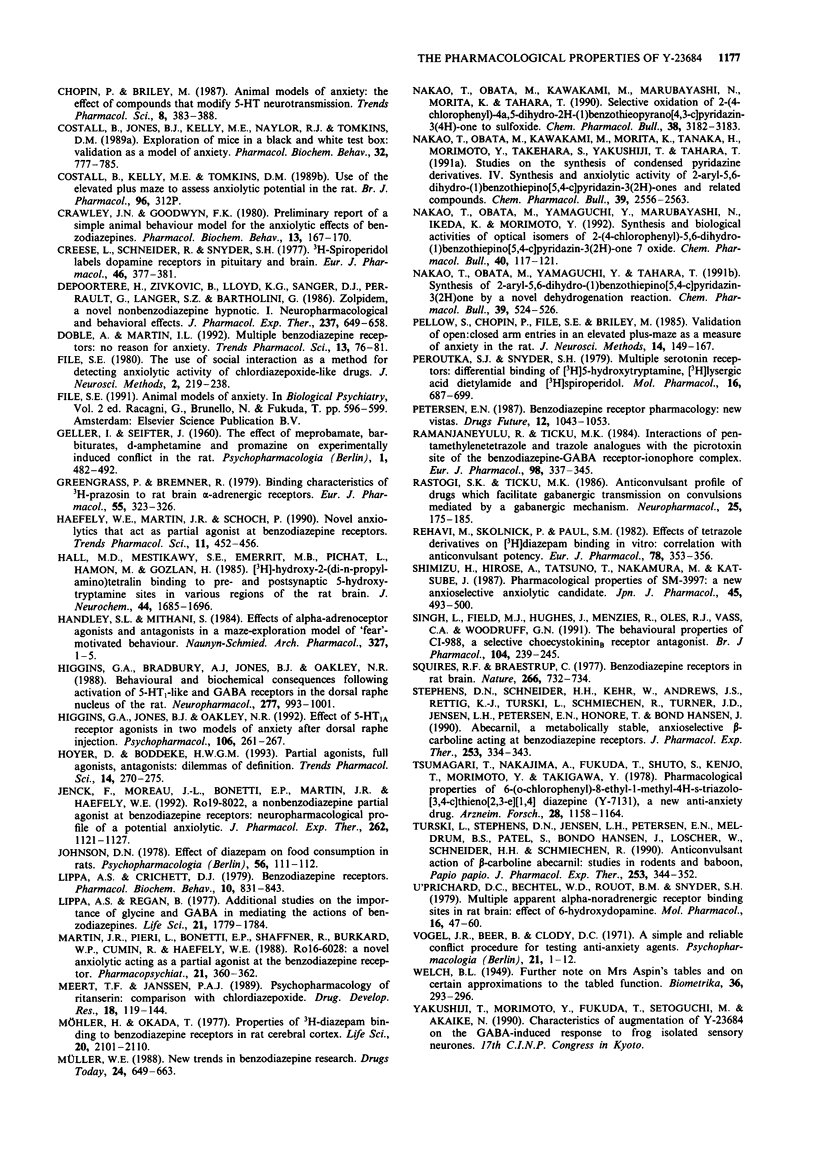

Selected References
These references are in PubMed. This may not be the complete list of references from this article.
- Beaumont K., Chilton W. S., Yamamura H. I., Enna S. J. Muscimol binding in rat brain: association with synaptic GABA receptors. Brain Res. 1978 Jun 9;148(1):153–162. doi: 10.1016/0006-8993(78)90385-2. [DOI] [PubMed] [Google Scholar]
- Bowery N. G., Hill D. R., Hudson A. L. Characteristics of GABAB receptor binding sites on rat whole brain synaptic membranes. Br J Pharmacol. 1983 Jan;78(1):191–206. doi: 10.1111/j.1476-5381.1983.tb09380.x. [DOI] [PMC free article] [PubMed] [Google Scholar]
- Costall B., Jones B. J., Kelly M. E., Naylor R. J., Tomkins D. M. Exploration of mice in a black and white test box: validation as a model of anxiety. Pharmacol Biochem Behav. 1989 Mar;32(3):777–785. doi: 10.1016/0091-3057(89)90033-6. [DOI] [PubMed] [Google Scholar]
- Crawley J., Goodwin F. K. Preliminary report of a simple animal behavior model for the anxiolytic effects of benzodiazepines. Pharmacol Biochem Behav. 1980 Aug;13(2):167–170. doi: 10.1016/0091-3057(80)90067-2. [DOI] [PubMed] [Google Scholar]
- Creese I., Schneider R., Snyder S. H. 3H-Spiroperidol labels dopamine receptors in pituitary and brain. Eur J Pharmacol. 1977 Dec 15;46(4):377–381. doi: 10.1016/0014-2999(77)90232-1. [DOI] [PubMed] [Google Scholar]
- Depoortere H., Zivkovic B., Lloyd K. G., Sanger D. J., Perrault G., Langer S. Z., Bartholini G. Zolpidem, a novel nonbenzodiazepine hypnotic. I. Neuropharmacological and behavioral effects. J Pharmacol Exp Ther. 1986 May;237(2):649–658. [PubMed] [Google Scholar]
- Doble A., Martin I. L. Multiple benzodiazepine receptors: no reason for anxiety. Trends Pharmacol Sci. 1992 Feb;13(2):76–81. doi: 10.1016/0165-6147(92)90027-4. [DOI] [PubMed] [Google Scholar]
- File S. E. The use of social interaction as a method for detecting anxiolytic activity of chlordiazepoxide-like drugs. J Neurosci Methods. 1980 Jun;2(3):219–238. doi: 10.1016/0165-0270(80)90012-6. [DOI] [PubMed] [Google Scholar]
- Greengrass P., Bremner R. Binding characteristics of 3H-prazosin to rat brain alpha-adrenergic receptors. Eur J Pharmacol. 1979 May 1;55(3):323–326. doi: 10.1016/0014-2999(79)90202-4. [DOI] [PubMed] [Google Scholar]
- Haefely W., Martin J. R., Schoch P. Novel anxiolytics that act as partial agonists at benzodiazepine receptors. Trends Pharmacol Sci. 1990 Nov;11(11):452–456. doi: 10.1016/0165-6147(90)90126-s. [DOI] [PubMed] [Google Scholar]
- Hall M. D., el Mestikawy S., Emerit M. B., Pichat L., Hamon M., Gozlan H. [3H]8-hydroxy-2-(di-n-propylamino)tetralin binding to pre- and postsynaptic 5-hydroxytryptamine sites in various regions of the rat brain. J Neurochem. 1985 Jun;44(6):1685–1696. doi: 10.1111/j.1471-4159.1985.tb07155.x. [DOI] [PubMed] [Google Scholar]
- Handley S. L., Mithani S. Effects of alpha-adrenoceptor agonists and antagonists in a maze-exploration model of 'fear'-motivated behaviour. Naunyn Schmiedebergs Arch Pharmacol. 1984 Aug;327(1):1–5. doi: 10.1007/BF00504983. [DOI] [PubMed] [Google Scholar]
- Higgins G. A., Bradbury A. J., Jones B. J., Oakley N. R. Behavioural and biochemical consequences following activation of 5HT1-like and GABA receptors in the dorsal raphé nucleus of the rat. Neuropharmacology. 1988 Oct;27(10):993–1001. doi: 10.1016/0028-3908(88)90058-5. [DOI] [PubMed] [Google Scholar]
- Higgins G. A., Jones B. J., Oakley N. R. Effect of 5-HT1A receptor agonists in two models of anxiety after dorsal raphe injection. Psychopharmacology (Berl) 1992;106(2):261–267. doi: 10.1007/BF02801982. [DOI] [PubMed] [Google Scholar]
- Hoyer D., Boddeke H. W. Partial agonists, full agonists, antagonists: dilemmas of definition. Trends Pharmacol Sci. 1993 Jul;14(7):270–275. doi: 10.1016/0165-6147(93)90129-8. [DOI] [PubMed] [Google Scholar]
- Jenck F., Moreau J. L., Bonetti E. P., Martin J. R., Haefely W. E. Ro 19-8022, a nonbenzodiazepine partial agonist at benzodiazepine receptors: neuropharmacological profile of a potential anxiolytic. J Pharmacol Exp Ther. 1992 Sep;262(3):1121–1127. [PubMed] [Google Scholar]
- Johnson D. N. Effect of diazepam on food consumption in rats. Psychopharmacology (Berl) 1978 Jan 31;56(1):111–112. doi: 10.1007/BF00571417. [DOI] [PubMed] [Google Scholar]
- Lippa A. S., Critchett D., Sano M. C., Klepner C. A., Greenblatt E. N., Coupet J., Beer B. Benzodiazepine receptors: cellular and behavioral characteristics. Pharmacol Biochem Behav. 1979 May;10(5):831–843. doi: 10.1016/0091-3057(79)90342-3. [DOI] [PubMed] [Google Scholar]
- Lippa A. S., Regan B. Additional studies on the importance of glycine and GABA in mediating the actions of benzodiazepines. Life Sci. 1977 Dec 15;21(12):1779–1783. doi: 10.1016/0024-3205(77)90158-8. [DOI] [PubMed] [Google Scholar]
- Martin J. R., Pieri L., Bonetti E. P., Schaffner R., Burkard W. P., Cumin R., Haefely W. E. Ro 16-6028: a novel anxiolytic acting as a partial agonist at the benzodiazepine receptor. Pharmacopsychiatry. 1988 Nov;21(6):360–362. doi: 10.1055/s-2007-1021947. [DOI] [PubMed] [Google Scholar]
- Möhler H., Okada T. Properties of 3H-diazepam binding to benzodiazepine receptors in rat cerebral cortex. Life Sci. 1977 Jun 15;20(12):2101–2110. doi: 10.1016/0024-3205(77)90191-6. [DOI] [PubMed] [Google Scholar]
- Nakao T., Obata M., Kawakami M., Morita K., Tanaka H., Morimoto Y., Takehara S., Yakushiji T., Tahara T. Studies on the synthesis of condensed pyridazine derivatives. IV. Synthesis and anxiolytic activity of 2-aryl-5,6-dihydro-(1)benzothiepino[5,4- c]pyridazin-3(2H)-ones and related compound. Chem Pharm Bull (Tokyo) 1991 Oct;39(10):2556–2563. doi: 10.1248/cpb.39.2556. [DOI] [PubMed] [Google Scholar]
- Nakao T., Obata M., Yamaguchi Y., Marubayashi N., Ikeda K., Morimoto Y. Synthesis and biological activities of optical isomers of 2-(4-chlorophenyl)-5,6-dihydro-(1)benzothiepino[5,4-c]pyridazin-3(2H)-o ne 7-oxide. Chem Pharm Bull (Tokyo) 1992 Jan;40(1):117–121. doi: 10.1248/cpb.40.117. [DOI] [PubMed] [Google Scholar]
- Pellow S., Chopin P., File S. E., Briley M. Validation of open:closed arm entries in an elevated plus-maze as a measure of anxiety in the rat. J Neurosci Methods. 1985 Aug;14(3):149–167. doi: 10.1016/0165-0270(85)90031-7. [DOI] [PubMed] [Google Scholar]
- Peroutka S. J., Snyder S. H. Multiple serotonin receptors: differential binding of [3H]5-hydroxytryptamine, [3H]lysergic acid diethylamide and [3H]spiroperidol. Mol Pharmacol. 1979 Nov;16(3):687–699. [PubMed] [Google Scholar]
- Ramanjaneyulu R., Ticku M. K. Interactions of pentamethylenetetrazole and tetrazole analogues with the picrotoxinin site of the benzodiazepine-GABA receptor-ionophore complex. Eur J Pharmacol. 1984 Mar 2;98(3-4):337–345. doi: 10.1016/0014-2999(84)90282-6. [DOI] [PubMed] [Google Scholar]
- Rastogi S. K., Ticku M. K. Anticonvulsant profile of drugs which facilitate GABAergic transmission on convulsions mediated by a GABAergic mechanism. Neuropharmacology. 1986 Feb;25(2):175–185. doi: 10.1016/0028-3908(86)90039-0. [DOI] [PubMed] [Google Scholar]
- Rehavi M., Skolnick P., Paul S. M. Effects of tetrazole derivatives on [3H]diazepam binding in vitro: correlation with convulsant potency. Eur J Pharmacol. 1982 Mar 12;78(3):353–356. doi: 10.1016/0014-2999(82)90037-1. [DOI] [PubMed] [Google Scholar]
- Shimizu H., Hirose A., Tatsuno T., Nakamura M., Katsube J. Pharmacological properties of SM-3997: a new anxioselective anxiolytic candidate. Jpn J Pharmacol. 1987 Dec;45(4):493–500. doi: 10.1254/jjp.45.493. [DOI] [PubMed] [Google Scholar]
- Singh L., Field M. J., Hughes J., Menzies R., Oles R. J., Vass C. A., Woodruff G. N. The behavioural properties of CI-988, a selective cholecystokininB receptor antagonist. Br J Pharmacol. 1991 Sep;104(1):239–245. doi: 10.1111/j.1476-5381.1991.tb12413.x. [DOI] [PMC free article] [PubMed] [Google Scholar]
- Squires R. F., Brastrup C. Benzodiazepine receptors in rat brain. Nature. 1977 Apr 21;266(5604):732–734. doi: 10.1038/266732a0. [DOI] [PubMed] [Google Scholar]
- Stephens D. N., Schneider H. H., Kehr W., Andrews J. S., Rettig K. J., Turski L., Schmiechen R., Turner J. D., Jensen L. H., Petersen E. N. Abecarnil, a metabolically stable, anxioselective beta-carboline acting at benzodiazepine receptors. J Pharmacol Exp Ther. 1990 Apr;253(1):334–343. [PubMed] [Google Scholar]
- Tsumagari T., Nakajima A., Fukuda T., Shuto S., Kenjo T., Morimoto Y., Takigawa Y. Pharmacological properties of 6-(o-chlorophenyl)-8-ethyl-1-methyl-4H-s-triazolo[3,4-c]thieno[2,3-e] [1,4]diazepine (Y-7131), a new anti-anxiety drug. Arzneimittelforschung. 1978;28(7):1158–1164. [PubMed] [Google Scholar]
- Turski L., Stephens D. N., Jensen L. H., Petersen E. N., Meldrum B. S., Patel S., Hansen J. B., Löscher W., Schneider H. H., Schmiechen R. Anticonvulsant action of the beta-carboline abecarnil: studies in rodents and baboon, Papio papio. J Pharmacol Exp Ther. 1990 Apr;253(1):344–352. [PubMed] [Google Scholar]
- U'Prichard D. C., Bechtel W. D., Rouot B. M., Snyder S. H. Multiple apparent alpha-noradrenergic receptor binding sites in rat brain: effect of 6-hydroxydopamine. Mol Pharmacol. 1979 Jul;16(1):47–60. [PubMed] [Google Scholar]
- Vogel J. R., Beer B., Clody D. E. A simple and reliable conflict procedure for testing anti-anxiety agents. Psychopharmacologia. 1971;21(1):1–7. doi: 10.1007/BF00403989. [DOI] [PubMed] [Google Scholar]
- Yakushiji T., Shirasaki T., Munakata M., Hirata A., Akaike N. Differential properties of type I and type II benzodiazepine receptors in mammalian CNS neurones. Br J Pharmacol. 1993 Jul;109(3):819–825. doi: 10.1111/j.1476-5381.1993.tb13648.x. [DOI] [PMC free article] [PubMed] [Google Scholar]
- Zivkovic B., Morel E., Joly D., Perrault G., Sanger D. J., Lloyd K. G. Pharmacological and behavioral profile of alpidem as an anxiolytic. Pharmacopsychiatry. 1990 May;23 (Suppl 3):108–113. doi: 10.1055/s-2007-1014545. [DOI] [PubMed] [Google Scholar]


